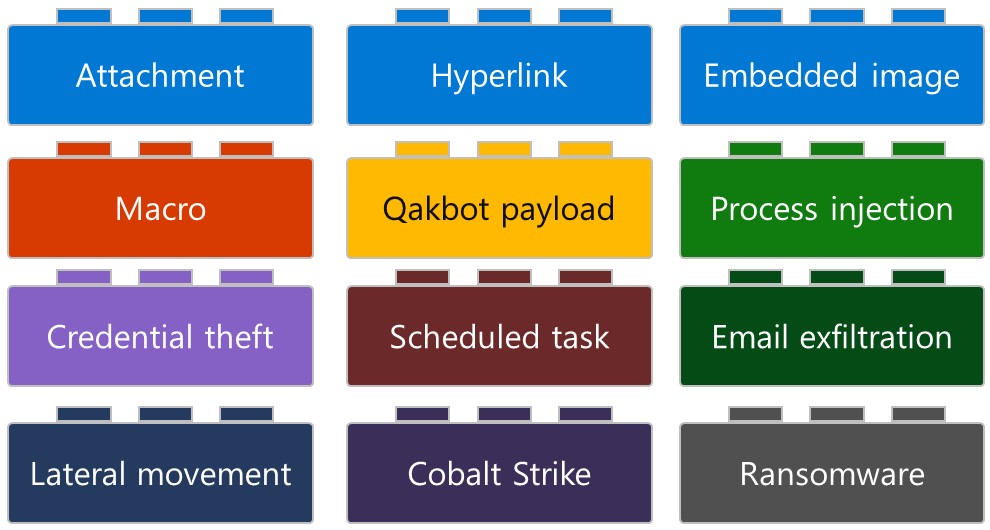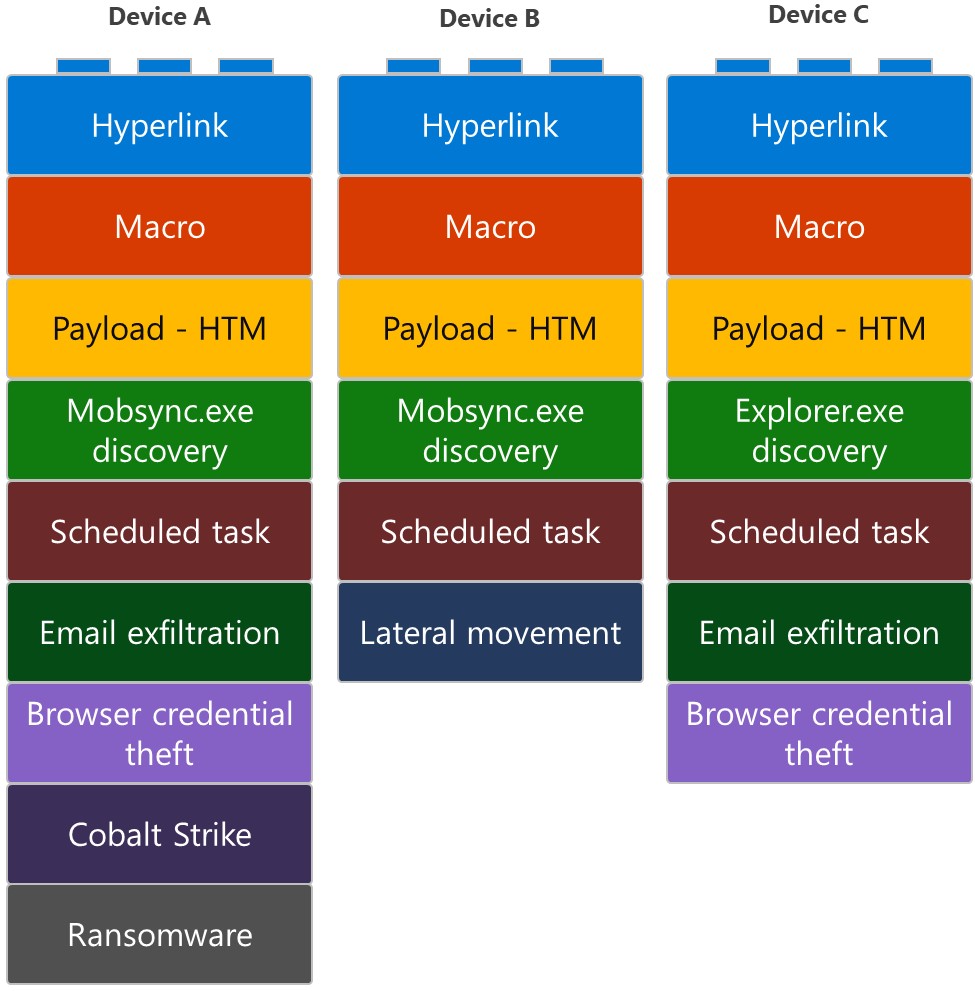As QBot campaigns increase in size and frequency, researchers are looking into ways to break the trojan's distribution chain and tackle the threat.
Over the past few years, Qbot (Qakbot or QuakBot) has grown into widely spread Windows malware that allows threat actors to steal bank credentials and Windows domain credentials, spread to other computers, and provide remote access to ransomware gangs.
Victims usually become infected with Qbot through another malware infection or via phishing campaigns using various lures, including fake invoices, payment and banking information, scanned documents, or invoices.
Ransomware gangs known to have used Qbot to breach corporate networks include REvil, Egregor, ProLock, PwndLocker, and MegaCortex strains.
Due to this, understanding how threat actors infiltrate and move in a Qbot compromised environment is critical for helping defenders stop intruders before they can unleash devastating attacks.
Building blocks
In a new report, Microsoft breaks down the QBot attack chain into distinct "building blocks," which can be different depending on the operator using the malware and the type of attack they are conducting.
To illustrate an attack chain, Microsoft used Lego pieces of different colors, each representing a step in an attack.
"However, based on our analysis, one can break down a Qakbot-related incident into a set of distinct “building blocks,” which can help security analysts identify and respond to Qakbot campaigns," explains the research by Microsoft.
"Figure 1 below represents these building blocks. From our observation, each Qakbot attack chain can only have one block of each color. The first row and the macro block represent the email mechanism used to deliver Qakbot."

Source: Microsoft
These different attack chains are either the result of a highly-targeted approach or an attempt to succeed in a single infiltration point by trying out multiple attack channels simultaneously.
Even when looking at three devices targeted in the same campaign, the attackers may use three different attack chains.
For example, Device A ultimately suffers a ransomware attack, while Device B is used for lateral movement, and Device C is used to steal credentials.

Source: Microsoft
The use of different attach chains in the same attack underlines the importance of analyzing all evidence in post-attack investigations, as no safe conclusions can be drawn by looking into sample logs or what occurred on one device.
Qbot attacks start with an email
Whatever happens in later stages, it is essential to underline that the QBot threat begins with the arrival of an email carrying malicious links, attachments, or embedded images.
The messages are typically short, containing a call to action that email security solutions ignore.
Using embedded links is the weakest approach, as many are missing the HTTP or HTTPS protocol in the URLs, making them not clickable in most email clients. Furthermore, the use of non-clickable URLs is likely to bypass email security solutions by not being an HTML link.
However, recipients are unlikely to copy and paste these URLs on a new tab, so the success rates drop.

Source: Microsoft
However, their chances get much better when the actors hijack email threads to construct a spoofed reply.
We’ve seen this type of internal reply chain attack working successfully against IKEA recently, and it’s particularly hard for security solutions to track and stop it.
In the cases of malicious attachments, the attacks are again weak because most security products would flag ZIP attachments as potentially malicious.
The latest addition in QBot’s delivery repertoire is embedded images in the email body, which contain the malicious URLs.

Source: Microsoft
Again, this is another way to evade content security tool detection, as the image is a screenshot of text urging the recipient to type the link themselves.
Doing so results in downloading a laced Excel file that carries the malicious macros that eventually load QBot on the machine.
Later building blocks
After the delivery of the email, Qbot attack chains use the following building blocks:
- Macro enablement - Every Qbot campaign delivered via email utilizes malicious macros to deliver the Qbot payload.
- Qakbot delivery - Qbot is typically downloaded as an executable with an htm or .dat exension, and then renamed to non-existent file extensions like .waGic or .wac. Microsoft notes that in many cases, the Qbot delivery includes creating a C:\Datop folder as described in this article.
- Process injection for discovery - Qbot payloads are then injected as DLLs into other processes, most commonly MSRA.exe and Mobsync.exe.
- Scheduled tasks - Creates a scheduled task so that Qbot is launched every time Windows is restarted and a user logs into the device.
- Credential and browser data theft - Steal credentials from the Windows Credential Manager and browser history, passwords, and cookies from installed web browsers.
- Email exfiltration - Steal email from infected devices that the attackers use in other reply-chain phishing attacks against employees and business partners.
- Additional payloads, lateral movement, and ransomware - This block in the attack chain is for a variety of different malicious activity and payloads, including deploying Cobalt Strike beacons, spreading laterally through the network, and deploying ransomware.
QBot distribution started spiking again in November 2021 and is helped further with the emergence of the 'Squirrelwaffle' attacks.
As QBot infections can lead to various dangerous and disruptive attacks, all admins need to become intimately familiar with the malware and the tactics it uses to spread throughout a network.
Since all infections begin with an email, it is crucial to focus your vigilance there, avoid clicking on unknown URLs or enabling macros, and provide employees with phishing awareness training.
For those interested in hunting QBot, Microsoft refreshes this GitHub repository with up-to-date queries frequently.
Microsoft: These are the building blocks of QBot malware attacks
- aum
-

 1
1



3175x175(CURRENT).thumb.jpg.b05acc060982b36f5891ba728e6d953c.jpg)
Recommended Comments
There are no comments to display.
Join the conversation
You can post now and register later. If you have an account, sign in now to post with your account.
Note: Your post will require moderator approval before it will be visible.